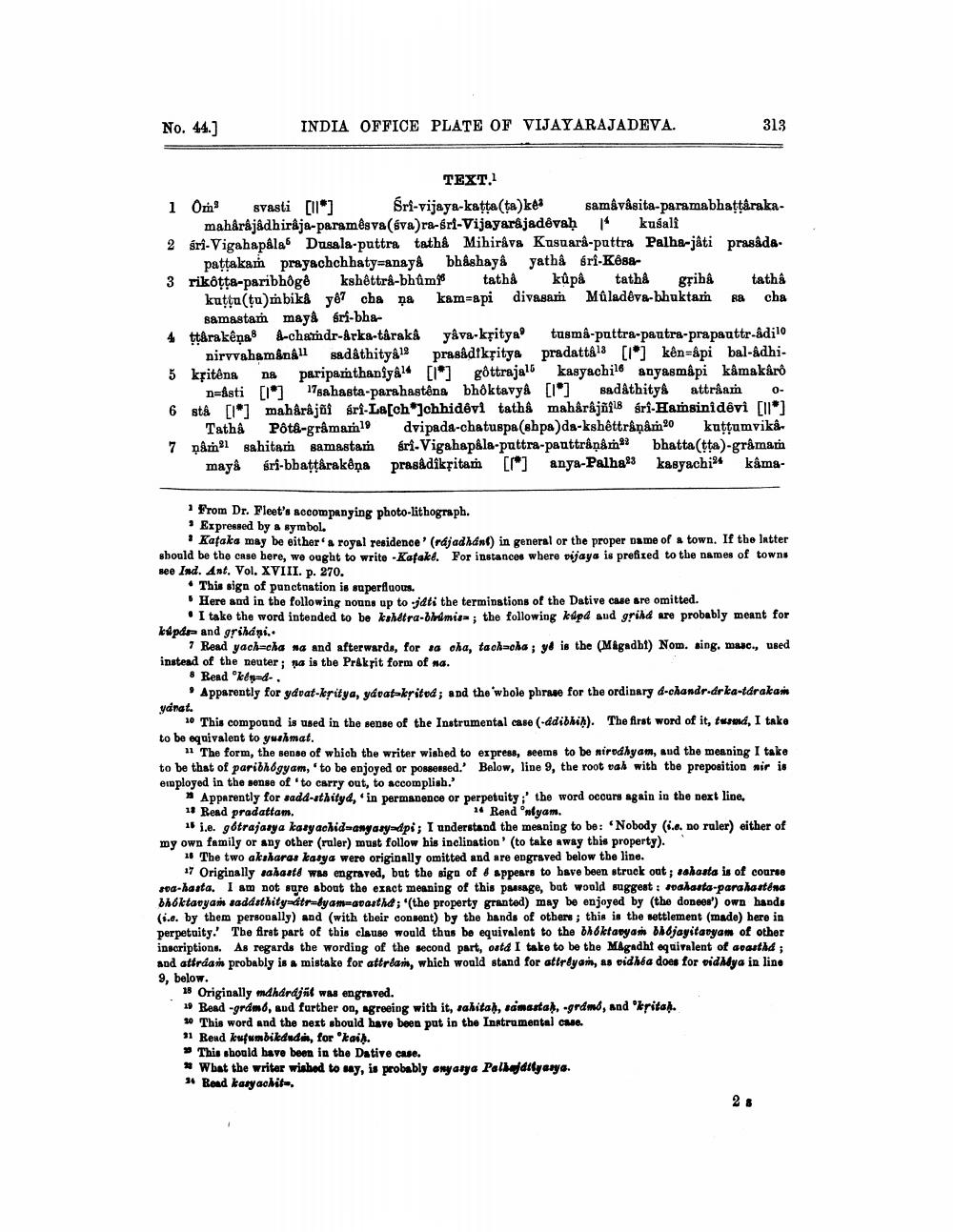________________
No. 44.)
INDIA OFFICE PLATE OF VIJAYARAJADEVA.
313
TEXT. 1 Om svasti [11*] Sri-vijaya-katta(ta)kes samåvåsita-paramabhattaraka
maharajadhiraja-paramêsva(sva)ra-fri-Vijayarajadevah kusalt 2 sri-Vigahapala Dusala-puttra tath& Mihiråva Kusuara-puttra Palha-jâti prasada
pattakam prayachchhaty=anay bhashaya yatha Sri-Kesa3 rikotta-paribhoge kshêttrå-bhůmys tathi kúpå tatha gribi tatha
kutça(tu)mbik& y87 cha na kam=api divasam Mûladēva-bhuktam a cha
samastam maya sri-bhs4 ttårakêņa A-charidr-arka-târaka yâva-ksitya" tusmâ-puttra-paatra-prapauttr-adilo
nirvvahaman sad&thitya 19 prasadiksitya pradatt&13 [1] kên=&pi bal-Adhi5 kpitena na paripamthaniya [1] gôttrajalo kasyachi 6 anyasmapi kâmakaro
n=asti [1] 178ahasta-parahastêns bhôktavyâ [] sad&thitys attråar 06 stá n°1 maharajai gri-La[chJchhidêvi tathi maharajñile sri-Hamsinidevi (11
Tatha Pot&-grâmar dvipada-chatuspa (shpa)da-kshêttråņâm20 kuttumvika7 DÂm gahitam samasta sri-Vigahapala-puttra-pauttråņâm bhatta(tta)-gråmam
may& fri-bhattarakêņa prasadikfitam [*] anya-Palha 3 kasyachi kama
From Dr. Fleet's accompanying photo-lithograph. • Expressed by a symbol
Kafaka may be either royal residence' (rajadhanl) in general or the proper name of a town. If the latter should be the case bere, we ought to write - Kafake. For instances where vijaya is prefixed to the names of towns seo Ind. Ant. Vol. XVIII. p. 270.
• This sign of punctnation is superfluous.
Here and in the following nouns up to jdti the terminations of the Dative case are omitted.
• I take the word intended to be kshetra-brimis; the following kúpd aud grind are probably meant for kapde and grindi..
7 Read yachacha na and afterwards, for a cha, tack-cha; yd is the (Magadht) Nom. sing. masc., used instead of the neuter; ma is the Prekrit form of na.
& Rend kép-d..
. Apparently for ydvat-kritya, ydrat-krited; and the whole phrase for the ordinary d-chandr.drka-tdrakan yanat.
10 This compound is used in the sense of the Instrumental case (-adibhih). The first word of it, tusend, I take to be equivalent to yuahmat.
11 The form, the sense of which the writer wished to express, seems to be sirodhyam, and the meaning I take to be that of paribhbgyam, 'to be enjoyed or possessed.' Below, line 9, the root val with the preposition nir is employed in the sense of 'to carry out, to accomplish.
Apparently for sadd-sthityd, in permanence or perpetuity :' the word occurs again in the next line 11 Read pradattam.
2. Read onlyam. 15 i.e. gotrajasya kasy achidaanyasyadpi; I understand the meaning to be: "Nobody (.o. no ruler) either of my own family or any other (ruler) must follow his inclination' (to take away this property).
The two akaharas katya were originally omitted and are engraved below the line. 17 Originally salaatd was engraved, but the siga of 6 sppears to bave been struck out; shasta is of course sea-hasta. I am not sure about the exact meaning of this passage, but would suggest : salasta-parahastens Dhoktaryan saddsthity tradyam-avastha;'(the property granted) may be enjoyed by the donees') own hands (i... by them personally) and (with their consent) by the hands of others; this is the settlement (made) here in perpetuity. The first part of this clause would thus be equivalent to the bh6ktaryan bhojayitaryam of other inscriptions. As regards the wording of the second part, osta I take to be the Magadht equivalent of coastha; and attrdania probably is a mistake for attrian, which would stand for attrayani, as pidhéa does for vid Mya in line 9, below.
10 Originally mdhardjit was engraved. 1) Read -grdno, aud further on, agreeing with it, ahital, seinastah, .grdmd, and 'krita. 10 This word and the next should have been put in the Instrumental caso. 11 Rend kufumbiledudu, forkait. » This should have been in the Dative case. * What the writer wished to say, is probably anyanya Pallayanya. 34 Read kasy achite




